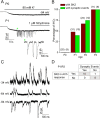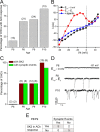Onset of cholinergic efferent synaptic function in sensory hair cells of the rat cochlea
- PMID: 22016543
- PMCID: PMC3213862
- DOI: 10.1523/JNEUROSCI.2743-11.2011
Onset of cholinergic efferent synaptic function in sensory hair cells of the rat cochlea
Abstract
In the developing mammalian cochlea, the sensory hair cells receive efferent innervation originating in the superior olivary complex. This input is mediated by α9/α10 nicotinic acetylcholine receptors (nAChRs) and is inhibitory due to the subsequent activation of calcium-dependent SK2 potassium channels. We examined the acquisition of this cholinergic efferent input using whole-cell voltage-clamp recordings from inner hair cells (IHCs) in acutely excised apical turns of the rat cochlea from embryonic day 21 to postnatal day 8 (P8). Responses to 1 mm acetylcholine (ACh) were detected from P0 on in almost every IHC. The ACh-activated current amplitude increased with age and demonstrated the same pharmacology as α9-containing nAChRs. Interestingly, at P0, the ACh response was not coupled to SK2 channels, so that the initial cholinergic response was excitatory and could trigger action potentials in IHCs. Coupling to SK current was detected earliest at P1 in a subset of IHCs and by P3 in every IHC studied. Clustered nAChRs and SK2 channels were found on IHCs from P1 on using Alexa Fluor 488 conjugated α-bungarotoxin and SK2 immunohistochemistry. The number of nAChRs clusters increased with age to 16 per IHC at P8. Cholinergic efferent synaptic currents first appeared in a subset of IHCs at P1 and by P3 in every IHC studied, contemporaneously with ACh-evoked SK currents, suggesting that SK2 channels may be necessary at onset of synaptic function. An analogous pattern of development was observed for the efferent synapses that form later (P6-P8) on outer hair cells in the basal cochlea.
Figures





Similar articles
-
Assessment of the expression and role of the α1-nAChR subunit in efferent cholinergic function during the development of the mammalian cochlea.J Neurophysiol. 2016 Aug 1;116(2):479-92. doi: 10.1152/jn.01038.2015. Epub 2016 Apr 20. J Neurophysiol. 2016. PMID: 27098031 Free PMC article.
-
Expression of the SK2 calcium-activated potassium channel is required for cholinergic function in mouse cochlear hair cells.J Physiol. 2008 Nov 15;586(22):5471-85. doi: 10.1113/jphysiol.2008.160077. Epub 2008 Sep 25. J Physiol. 2008. PMID: 18818242 Free PMC article.
-
Developmental regulation of nicotinic synapses on cochlear inner hair cells.J Neurosci. 2004 Sep 8;24(36):7814-20. doi: 10.1523/JNEUROSCI.2102-04.2004. J Neurosci. 2004. PMID: 15356192 Free PMC article.
-
The efferent medial olivocochlear-hair cell synapse.J Physiol Paris. 2012 Jan;106(1-2):47-56. doi: 10.1016/j.jphysparis.2011.06.001. Epub 2011 Jul 6. J Physiol Paris. 2012. PMID: 21762779 Free PMC article. Review.
-
Cholinergic and purinergic signalling in outer hair cells of mammalian cochlea.Neurochem Int. 1995 Oct-Nov;27(4-5):301-11. doi: 10.1016/0197-0186(95)00011-v. Neurochem Int. 1995. PMID: 8845730 Review.
Cited by
-
Cholinergic efferent synaptic transmission regulates the maturation of auditory hair cell ribbon synapses.Open Biol. 2013 Nov;3(11):130163. doi: 10.1098/rsob.130163. Open Biol. 2013. PMID: 24350389 Free PMC article.
-
SK Current, Expressed During the Development and Regeneration of Chick Hair Cells, Contributes to the Patterning of Spontaneous Action Potentials.Front Cell Neurosci. 2022 Jan 6;15:766264. doi: 10.3389/fncel.2021.766264. eCollection 2021. Front Cell Neurosci. 2022. PMID: 35069114 Free PMC article.
-
Taperin bundles F-actin at stereocilia pivot points enabling optimal lifelong mechanosensitivity.J Cell Biol. 2025 Aug 4;224(8):e202408026. doi: 10.1083/jcb.202408026. Epub 2025 Jun 5. J Cell Biol. 2025. PMID: 40471101 Free PMC article.
-
Voltage-Gated Calcium Influx Modifies Cholinergic Inhibition of Inner Hair Cells in the Immature Rat Cochlea.J Neurosci. 2018 Jun 20;38(25):5677-5687. doi: 10.1523/JNEUROSCI.0230-18.2018. Epub 2018 May 22. J Neurosci. 2018. PMID: 29789373 Free PMC article.
-
Activation of BK and SK channels by efferent synapses on outer hair cells in high-frequency regions of the rodent cochlea.J Neurosci. 2015 Feb 4;35(5):1821-30. doi: 10.1523/JNEUROSCI.2790-14.2015. J Neurosci. 2015. PMID: 25653344 Free PMC article.
References
-
- Anand R, Peng X, Lindstrom J. Homomeric and native alpha 7 acetylcholine receptors exhibit remarkably similar but non-identical pharmacological properties, suggesting that the native receptor is a heteromeric protein complex. FEBS Lett. 1993;327:241–246. - PubMed
-
- Bruce LL, Kingsley J, Nichols DH, Fritzsch B. The development of vestibulocochlear efferents and cochlear afferents in mice. Int J Dev Neurosci. 1997;15:671–692. - PubMed
-
- Bruce LL, Christensen MA, Warr WB. Postnatal development of efferent synapses in the rat cochlea. J Comp Neurol. 2000;423:532–548. - PubMed
Publication types
MeSH terms
Substances
Grants and funding
- R01DC006476/DC/NIDCD NIH HHS/United States
- R01 DC006476/DC/NIDCD NIH HHS/United States
- R01 DC000276/DC/NIDCD NIH HHS/United States
- P01 GM048677/GM/NIGMS NIH HHS/United States
- R01DC000276/DC/NIDCD NIH HHS/United States
- MH53631/MH/NIMH NIH HHS/United States
- R29 MH053631/MH/NIMH NIH HHS/United States
- P30 DC005211/DC/NIDCD NIH HHS/United States
- R24DK064388/DK/NIDDK NIH HHS/United States
- R24 DK064388/DK/NIDDK NIH HHS/United States
- R01 DC001508/DC/NIDCD NIH HHS/United States
- GM48677/GM/NIGMS NIH HHS/United States
- R01 MH053631/MH/NIMH NIH HHS/United States
LinkOut - more resources
Full Text Sources
Research Materials
